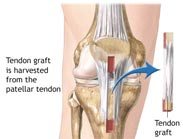Anterior Cruciate Ligament (ACL) Reconstruction
A tear of the anterior cruciate ligament is a common cause of knee pain seen by orthopedic surgeons. The anterior cruciate ligament is a major stabilizing ligament of the knee. The ligament is located in the center of the knee and joins the femur and tibia bone. Its function is to provide the knee with stability during activities such as pivoting, turning, jumping, and twisting. A tear of the ACL may be partial or complete.
Acute tear may be accompanied by an audible “pop” followed by knee swelling. The knee may become unstable with “giving way” episodes, especially with pivoting activities. Without the ligament acting as a stabilizer, further cartilage damage can occur to the meniscus and articular cartilage that lines the bones along with symptoms of pain, buckling, locking and catching.
The diagnosis is made with a careful clinical examination by your orthopedic surgeon. Radiographs (or x-rays) are helpful in ruling out other possible causes of knee pain such as a fracture or arthritis. Diagnostic studies such as an MRI scan or an ultrasound scan can pick up meniscus tears.
Initial treatment may require ice, compression and elevation. Your doctor may recommend an aspiration to remove accumulated knee fluid to allow for faster return to full range of motion. Patients with complete ACL tears may be sub-divided into three general categories based on knee symptoms. The first category is the patient who does not demonstrate significant instability. The second type of patient has instability episodes, however the patient is able to cope, with only limited symptoms. The third type of patient has significant instability and is unable to function with the ACL tear. Therapy, bracing, and activity modification may be recommended to the first and second type of patients, whereas surgery may be recommended for the third. Certain patients, such as professional and recreational athletes, dancers, and those whose physical activities require pivoting are ideal candidates for surgery. Patients with associated meniscus tears or significant cartilage tears may also be advised to proceed with surgery to prevent further injury to cartilage and to repair cartilage tears. A torn ligament generally cannot be repaired and must be reconstructed. Patients with meniscus tears may require meniscus repair or meniscectomy.
Your orthopedic surgeon can best advise you as to the appropriate treatment strategy. Anterior cruciate ligament reconstruction surgery can be performed as an outpatient procedure with an arthroscope, or minimally invasive camera procedure. The success rate for ACL reconstruction depends on several factors including: the chronicity of the ACL tear, the status of the cartilage in the rest of the knee, the type of graft utilized, the type of graft fixation, whether there is knee mechanical mal-alignment of the femur and tibia bones, and the level of activity the patient wishes to return to after surgery. The recurrence rate for ACL tears after surgery is variable (less than 10%). Return to full recovery is multi-factorial and depends on the procedures performed, patient age, as well as the surgical technique. Diligent physical therapy is paramount for a successful outcome.

Surgery is performed arthroscopically with the use of a camera placed through minimally invasive incisions into the knee. Additional small incisions are placed depending on the surgery performed. There are several surgical reconstructive options. The ligament may be reconstructed by harvesting a suitable tendon from the knee. The central slip of the patellar tendon and two bone plugs remains the “gold-standard” of ACL reconstruction surgery. Likewise, two hamstring tendons can also be harvested. The third option is an allograft or “cadaver” tendon. Your surgeon can explain the risks and benefits of each technique. The tendons are then placed into bone tunnels or sockets placed in the femur and tibia and affixed to the bone. After surgery, the patient is placed in a brace. Rehabilitation is essential after surgery to restore normal knee motion, strength, and function.
Dr. Hommen performs anterior cruciate ligament reconstruction surgery.
ACL Reconstruction Patellar Tendon
ACL Reconstruction Hamstring Tendon
Common Questions Regarding ACL Tears and Knee Arthroscopic Surgery
How Do ACL Tears Occur?
- Falls, twisting, or direct contusions injuries.
- Athletic injuries (football, soccer, volleyball, skiing etc.)
What Age Group is Commonly Affected by ACL tears?
- May occur in any age group.
- Adolescents to middle-age.
What Are the Symptoms of ACL tears?

- Pain at the time of injury and immediate swelling.
- Patient may hear or feel a “pop”.
- Knee stiffness, weakness, instability.
- The knee may “buckle”, “give-way” or “pivot” with activity.
- Instability with running, pivoting or even with walking.
- If the meniscus is also torn, the knee may become locked and difficult to bend or extend.
What Types of ACL Tears Are There?
- Partial (sprain) and complete.
How Are ACL Tears Diagnosed?

- By careful examination of the knee.
- By MRI scan or by arthroscopic surgery.
How Are ACL Tears Treated Without Surgery?
- Physical therapy.
- Activity modification.
- Anti-inflammatories (Motrin, Aleve) or Tylenol.
> What Happens If ACL Tears Are Not Reconstructed?
- Partial tears may be asymptomatic.
- Complete tears do not heal by themselves.
- Continued knee instability (“pivoting” or “giving-way”).
- Complete tears may lead to further problems such as meniscus tears, cartilage wear.
- Long term problems: potential knee arthritis.
Is There An Age Restriction for Surgery?
- Adolescents that are still growing may not be candidates for ACL reconstruction surgery as growth in the knee may be stunted. Surgery may be delayed late adolescence.
- The patient’s activity level and amount of instability help decide who may be a potential candidate.
- A careful pre-operative assessment from your medical internist can determine if you are a candidate for surgery.
When and Why Should I Have Surgery?
- If you continue to have knee pain, instability, locking or other symptoms despite therapy and medications.
- Smaller tears have better outcomes than larger tears. Tears may enlarge over time if not treated.
Is the Surgery Minimally Invasive?
- The surgery is performed arthroscopically.
- Depending on the technique used to reconstruct the ligament, the number and size of the incisions may vary.
How is The ACL Tear Treated Surgically?
- Reconstruction - The torn ACL is removed and is reconstructed using tendons from the patient’s own knee or using an “allograft” or cadaver tendon.
- Repair – In certain instances, the ACL torn ends may be sutured together.
- Own Graft Options:
- Patella tendon: the knee-cap bone and tendon are used and placed into a tunnel in both the femur and tibia.
- Hamstring tendon: two hamstrings tendons are used and placed into a tunnel in both the femur and tibia.
Allograft: a cadaver tendon is used and placed into a tunnel in both the femur and tibia.




Am I Also a Candidate for Meniscus and Cartilage Repair Surgery?

- Meniscus repairs are most successful in patients certain age populations.
- In those patients with an anterior cruciate ligament (ACL) tear and a meniscus tear, repairs of the meniscus are even more successful when performed at the same time as the ACL reconstruction.
- Concomitant cartilage injuries can be treated with cartilage transplantation, microfracture, or shaving techniques.
- Your doctor will be able to determine if you are a candidate for meniscus and cartilage surgery.
What Is Arthroscopic Surgery?

- A camera is inserted into the knee and viewed via a video monitor.
- The meniscus and other knee problems can be repaired.
What are the Benefits of Arthroscopic Surgery?
- A less invasive procedure with the benefits:
- less surgical dissection
- less surgical pain
- faster recovery rates
- better visualization of the knee anatomy
What Type of Anesthesia Will I Have?
- Arthroscopies are performed under regional or general anesthesia.
- Regional anesthesia includes spinal anesthesia, where the legs are numb only. Nerve blocks can also be used on certain patient for the procedure.
- General anesthesia is when the patient is completely asleep.
- A nerve block may be performed for pain relieve after surgery.
- Our dedicated team of anesthesiologists will be able to advise you as to which type anesthesia is best for your procedure.
- Do NOT make any important decisions after surgery since sedatives and other medications are given during the case.
What Can I Expect the Night Before Surgery?
- You may take your regularly scheduled medications.
- Certain medications must be stopped before surgery (such as blood thinners). A complete list will be given to you by our office staff.
- Do not eat or drink after midnight before your surgery.
- On the night before the surgery you will called by the hospital surgical team. They will discuss:
- When to arrive for your surgery
- When you can eat
- They will also answer questions you may have concerning medication, transportation, and other concerns.
What is an “All Inside” ACL Reconstruction?
- The ACL graft is placed into sockets in the femur and tibia rather than full tunnels that exit the cortical bone. The potential advantages are: smaller or less incisions, faster rehabilitation, and less post-operative pain.
What is a “Double Bundle” ACL Reconstruction?
- The normal ACL is made of two bundles – the Anteromedial Bundle and Posterolateral Bundle.
- Double-Bundle techniques aim to restore both of these bundles. By anatomically reconstructing both bundles, the new ligament will potentially provide more inherent stability than standard techniques.
The technique can be performed in a variety of manners and will likely require allograft tendon reconstruction.
Deciding If ACL Surgery Is for You.
Reasons to have ACL surgery
- You have completely torn your ACL or have a partial tear and your knee is very unstable.
- You have a chronic ACL deficiency that is affecting your quality of life.
- You have gone through a rehabilitation program and your knee is still unstable.
- ou have injured other parts of your knee, such as cartilage, meniscus, other ligaments, or tendons, or broken bones in the knee joint.
- You rely on a strong, stable knee for working or playing sports.
- You are willing and able to commit time and energy to a long and rigorous rehab program.
- You are in good health.
- You have an excellent chance of achieving favorable results with surgery and rehabilitation.
- ACL repair may be successful for an ACL that has torn away from the upper or lower leg bone (avulsion).
Reasons not to have ACL surgery
- You have a minor tear in your ACL, but your knee is stable.
- You do not need a strong, stable knee for work or sports.
- You are willing and able to stop doing activities that require a stable knee or to stop doing them at the same level of intensity.
- You can complete several months of rehab to reduce the risk of re-injuring your knee.
- You are not willing to commit time and energy to the rehab program necessary after surgery.
- You have health problems that make surgery more risky.
- There is a chance that you could be one of a small number of people who still have knee pain after surgery.
- A second surgery (revision ACL reconstruction) is sometimes necessary. This surgery is generally not as successful as the first surgery.
- Complications include risks common to all surgeries (such as infection), a limited range of motion in the knee, and pain or swelling during activity or sports.
Is My ACL Surgery Outpatient or Same Day Surgery?
- The majority of arthroscopic cases are outpatient procedures and patients are allowed to go home the same day of their procedure.
- In certain cases, patients may stay overnight for observation at the hospital and will be allowed to go home in the morning after surgery.
What Happens If I Have an Anesthesia Nerve Block?
- Patients who have a nerve block, will have prolonged anesthesia to the thigh and knee and may go home with the leg still “numb” and weak.
- Therefore, be careful to avoid any pressure, prolonged ice exposure, or injury to the lower extremity.
Can I Drive Home After Surgery?
- You should arrange transportation with family, friends, or other means for after surgery.
- You are NOT allowed to drive home after surgery.
What Kind of Pain Can I Expect Following Surgery?
- As with any surgery, there will be surgical pain. The benefit of arthroscopic surgery is the limited amount of surgical dissection and a faster recovery time.
- You will be prescribed narcotic medication to go home with.
- Do NOT make important decisions while taking narcotic medications.
What Range of Motion and Weight Bearing Can I Expect After Surgery?
- Maintain the brace until you are instructed to remove it.
- You will be instructed as to the amount of weight you may place on your knee after surgery.
- If the meniscus or cartilage was also repaired, you may be given range of motion restrictions.
- You may also be asked to use a CPM machine. This will be used at home to help restore range of motion to your knee.
- You will be given crutches or other assistive devices for walking after the surgery.
- You will be encouraged to practice fully extending your knee during the first two weeks after surgery.
When and How Do I Bathe or Shower After Surgery?
- Do not bathe or submerge the knee in a pool until Dr. Hommen has cleared you for such activity.
- You may shower after 72 hours if the incisions are dry.
When Do I Remove the Dressings?

- You may remove the knee dressings after 72 hours.
- Please do NOT remove the white sticky “steri-strips”.
- Towel-dry the incision after showering.
Do I Wear a Knee Brace After Surgery?
- Immobilization is used to protect ACL reconstruction.
- Please wear the brace after surgery as directed.
Why Do I Need to Have a Ted-Hose Compression Stocking?
- You may be given a ted-hose stocking after surgery.
- This helps prevent swelling in the foot, ankle and knee after surgery.
- It also helps reduce the risk of blood clots after surgery.
- Wear the stockings at least 2 weeks after surgery, however, 4 weeks is ideal.
Do I Need to Take a Blood Thinner After Surgery?
- The incidence of symptomatic deep vein thrombosis after ACL reconstruction surgery is low. For the majority of patients, the risks associated with anti-coagulant therapy out-weigh the risk of blood clots after surgery.
- If you have risk factors for blood clots (previous blood clot, family history of blood clot), then you may be prophylaxed with a blood thinner after surgery.
- Lovanox and Arixtra are injectable blood thinners and Coumadin and Xarelto are oral blood thinner that may be recommended after surgery.
- All patients are provided the option of anti-coagulant therapy after surgery.
What Pain Medications Do I Take After Surgery?
- You will be prescribed a narcotic for pain relief after surgery.
- You should continue the medications for the first 48 to 72 hours as directed and then wean the medications when you are able.
Do I Receive Rehabilitation After Surgery?
- Therapy begins according to a strict therapy schedule usually
- Physical therapy continues over a 16-week period.
- It will take approximately 10 months before returning to full activities.
- Return to full activity depends on: 1) type of reconstruction used, 2) if other cartilage or meniscus work was performed, 3) activity requirements, 4) and the reconstruction strength.
- Each patient has an individually designed rehab program.
Where Can I Do Therapy?
- Therapy is performed with a licensed therapist usually at approved outpatient therapy centers.
- Hommen will tailor a therapy protocol according to your needs that the therapist will follow.
When Can I Drive After Knee Arthroscopic Surgery?

- Each patient will respond differently to arthroscopy.
- Expect a restricted return to driving until directed by the doctor and therapist.
- Will require full control of the driving leg muscles and knee range of motion.













